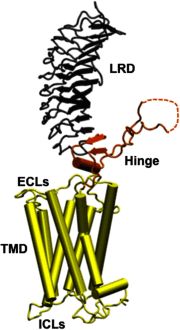Allosteric modulators hit the TSH receptor
- PMID: 24364583
- PMCID: PMC3868806
- DOI: 10.1210/en.2013-2079
Allosteric modulators hit the TSH receptor
Figures


Comment on
-
A selective TSH receptor antagonist inhibits stimulation of thyroid function in female mice.Endocrinology. 2014 Jan;155(1):310-4. doi: 10.1210/en.2013-1835. Epub 2013 Dec 4. Endocrinology. 2014. PMID: 24169564 Free PMC article.
Similar articles
-
A selective TSH receptor antagonist inhibits stimulation of thyroid function in female mice.Endocrinology. 2014 Jan;155(1):310-4. doi: 10.1210/en.2013-1835. Epub 2013 Dec 4. Endocrinology. 2014. PMID: 24169564 Free PMC article.
-
[Peptide 612-627 of thyrotropin receptor and its modified derivatives as the regulators of adenylyl cyclase in the rat thyroid gland].Tsitologiia. 2014;56(7):526-35. Tsitologiia. 2014. PMID: 25696997 Russian.
-
Antithyroid Drugs Inactivate TSH Binding to the TSH Receptor by their Reducing Action.Endocr Metab Immune Disord Drug Targets. 2018;18(5):508-512. doi: 10.2174/1871530318666180220101845. Endocr Metab Immune Disord Drug Targets. 2018. PMID: 29468987
-
[New achievements in the development and study of the mechanisms of action of the low molecular weight agonists of receptors of the thyroid-stimulating and the luteinizing hormones].Tsitologiia. 2015;57(3):167-76. Tsitologiia. 2015. PMID: 26021165 Review. Russian.
-
Past, presence and future of thyroid-stimulating hormone (TSH) superactive analogs.Cancer Treat Res. 2004;122:345-56. doi: 10.1007/1-4020-8107-3_19. Cancer Treat Res. 2004. PMID: 16209054 Review. No abstract available.
Cited by
-
Targeting the thyroid-stimulating hormone receptor with small molecule ligands and antibodies.Expert Opin Ther Targets. 2015 Jun;19(6):835-47. doi: 10.1517/14728222.2015.1018181. Epub 2015 Mar 13. Expert Opin Ther Targets. 2015. PMID: 25768836 Free PMC article. Review.
-
The "TSH Receptor Glo Assay" - A High-Throughput Detection System for Thyroid Stimulation.Front Endocrinol (Lausanne). 2016 Jan 28;7:3. doi: 10.3389/fendo.2016.00003. eCollection 2016. Front Endocrinol (Lausanne). 2016. PMID: 26858688 Free PMC article.
-
Molecular Insights into the Transmembrane Domain of the Thyrotropin Receptor.PLoS One. 2015 Nov 6;10(11):e0142250. doi: 10.1371/journal.pone.0142250. eCollection 2015. PLoS One. 2015. PMID: 26545118 Free PMC article.
-
Structure of full-length TSH receptor in complex with antibody K1-70™.J Mol Endocrinol. 2022 Dec 7;70(1):e220120. doi: 10.1530/JME-22-0120. Print 2023 Jan 1. J Mol Endocrinol. 2022. PMID: 36069797 Free PMC article.
-
New small molecule agonists to the thyrotropin receptor.Thyroid. 2015 Jan;25(1):51-62. doi: 10.1089/thy.2014.0119. Thyroid. 2015. PMID: 25333622 Free PMC article.
References
-
- Adams DD, Purves HD. Abnormal responses in the assay of thyrotropin. Proceedings of the University of Otago Medical School. 1956;34:11–12
-
- Smith BR, Hall R. Thyroid-stimulating immunoglobulins in Graves' disease. Lancet. 1974;2(7878):427–429 - PubMed
-
- Sanders J, Chirgadze DY, Sanders P, et al. Crystal structure of the TSH receptor in complex with a thyroid-stimulating autoantibody. Thyroid. 2007;17(5):395–410 - PubMed
-
- Calebiro D, Nikolaev VO, Persani L, Lohse MJ. Signaling by internalized G-protein-coupled receptors. Trends Pharmacol Sci. 2010;31(5):221–228 - PubMed
-
- Tanaka K, Chazenbalk GD, McLachlan SM, Rapoport B. Subunit structure of thyrotropin receptors expressed on the cell surface. J Biol Chem. 1999;274(48):33979–33984 - PubMed
Publication types
MeSH terms
Substances
Grants and funding
LinkOut - more resources
Full Text Sources
Other Literature Sources

